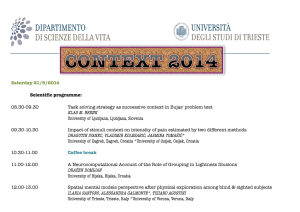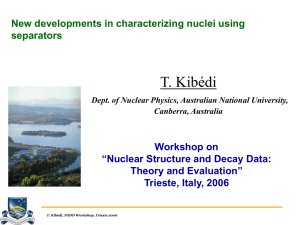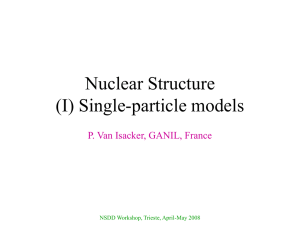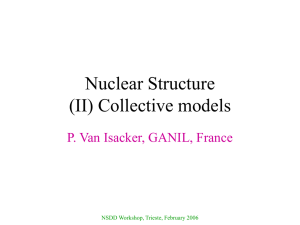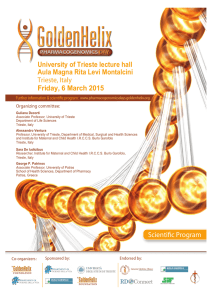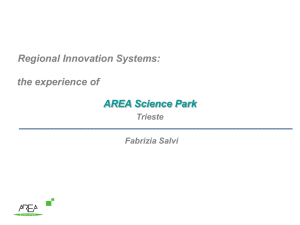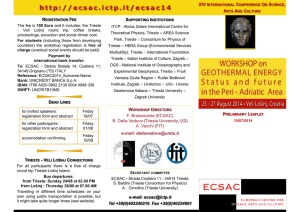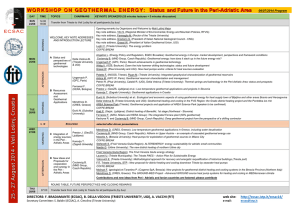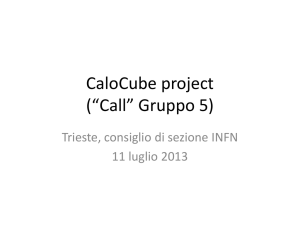Nuclear Structure Models - User web pages on web
advertisement
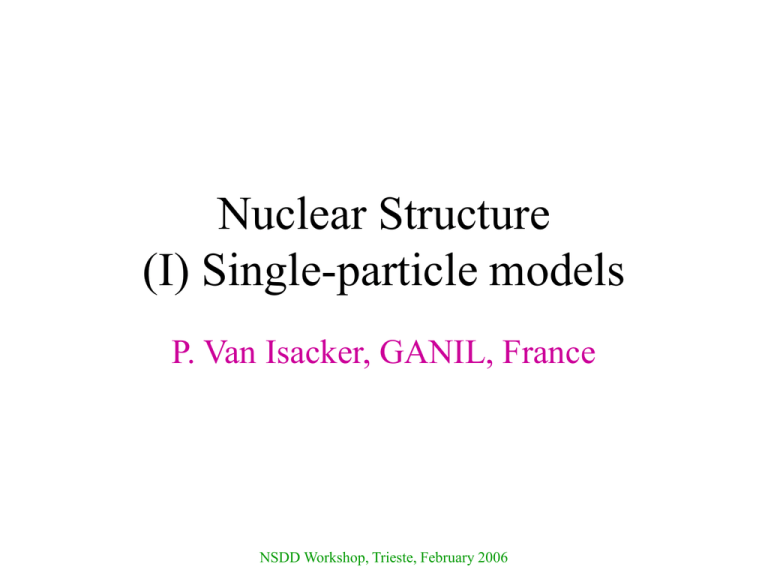
Nuclear Structure (I) Single-particle models P. Van Isacker, GANIL, France NSDD Workshop, Trieste, February 2006 Overview of nuclear models • Ab initio methods: Description of nuclei starting from the bare nn & nnn interactions. • Nuclear shell model: Nuclear average potential + (residual) interaction between nucleons. • Mean-field methods: Nuclear average potential with global parametrisation (+ correlations). • Phenomenological models: Specific nuclei or properties with local parametrisation. NSDD Workshop, Trieste, February 2006 Nuclear shell model • Many-body quantum mechanical problem: A A 2 p Hˆ k Vˆ2 rk ,rl 2mk kl k1 A pk2 A Vˆ rk Vˆ2 rk ,rl V rk kl k1 2mk k1 A mean field residual interaction • Independent-particle assumption. Choose V and neglect residual interaction: pk2 ˆ ˆ ˆ H HIP V rk k1 2mk A NSDD Workshop, Trieste, February 2006 Independent-particle shell model • Solution for one particle: p2 Vˆ r i r E ii r 2m • Solution for many particles: i1 i2 iA r1,r2 , A ,rA ik rk k1 Hˆ IPi1 i2 A ,rA E ik i1 i2 iA r1,r2 , k1 iA NSDD Workshop, Trieste, February 2006 r1,r2, ,rA Independent-particle shell model • Anti-symmetric solution for many particles (Slater determinant): i1 i2 iA r1,r2 , ,rA i r1 i r2 1 i r1 i r2 A! 1 1 2 2 i r1 i r2 A A • Example for A=2 particles: 1 i1 i2 r1,r2 i1 r1 i2 r2 i1 r2 i2 r1 2 NSDD Workshop, Trieste, February 2006 i rA i rA 1 2 i rA A Hartree-Fock approximation • Vary i (ie V) to minize the expectation value of H in a Slater determinant: * i1i2 * i1 i2 r1,r2 , i r1,r2 , iA A ,rA Hˆ i1 i2 ,rA i1 i2 r1,r2, r1,r2 , iA iA ,rA dr1dr2 ,rA dr1dr2 drA drA 0 • Application requires choice of H. Many global parametrizations (Skyrme, Gogny,…) have been developed. NSDD Workshop, Trieste, February 2006 Poor man’s Hartree-Fock • Choose a simple, analytically solvable V that approximates the microscopic HF potential: pk2 m 2 2 2 ˆ HIP rk lk sk lk 2 k1 2m A • Contains – Harmonic oscillator potential with constant . – Spin-orbit term with strength . – Orbit-orbit term with strength . • Adjust , and to best reproduce HF. NSDD Workshop, Trieste, February 2006 Harmonic oscillator solution • Energy eigenvalues of the harmonic oscillator: 1 1 l j l 2 E nlj N 32 2 ll 1 2 1 2 1 l 1 j l 2 2 N 2n l 0,1,2, : oscillatorquantumnumber n 0,1,2, : radialquantumnumber l N,N 2, ,1 or 0 : orbit alangular momentum j l 12 : totalangular momentum m j j, j 1, , j : z projectionof j NSDD Workshop, Trieste, February 2006 Energy levels of harmonic oscillator • Typical parameter values: 41 A1/ 3 MeV 2 20 A2 / 3 MeV 2 0.1 MeV b 1.0 A1/ 6 fm • ‘Magic’ numbers at 2, 8, 20, 28, 50, 82, 126, 184,… NSDD Workshop, Trieste, February 2006 Why an orbit-orbit term? • Nuclear mean field is close to Woods-Saxon: VˆWS r V0 r R0 1 exp a • 2n+l=N degeneracy is lifted El < El-2 < NSDD Workshop, Trieste, February 2006 Why a spin-orbit term? • Relativistic origin (ie Dirac equation). • From general invariance principles: 2 r 0 V ˆ VSO rl s, r in HO r r • Spin-orbit term is surface peaked diminishes for diffuse potentials. NSDD Workshop, Trieste, February 2006 Evidence for shell structure • Evidence for nuclear shell structure from – – – – 2+ in even-even nuclei [Ex, B(E2)]. Nucleon-separation energies & nuclear masses. Nuclear level densities. Reaction cross sections. • Is nuclear shell structure modified away from the line of stability? NSDD Workshop, Trieste, February 2006 Ionisation potential in atoms NSDD Workshop, Trieste, February 2006 Neutron separation energies NSDD Workshop, Trieste, February 2006 Proton separation energies NSDD Workshop, Trieste, February 2006 Liquid-drop mass formula • Binding energy of an atomic nucleus: 2 Z Z 1 N Z 2/3 BN,Z avol A asur A acou asym 1/ 3 apai N,Z A A A1/ 2 • For 2149 nuclei (N,Z ≥ 8) in AME03: avol16, asur18, acou0.71, asym23, apai13 rms2.93 MeV. C.F. von Weizsäcker, Z. Phys. 96 (1935) 431 H.A. Bethe & R.F. Bacher, Rev. Mod. Phys. 8 (1936) 82 NSDD Workshop, Trieste, February 2006 Deviations from LDM NSDD Workshop, Trieste, February 2006 Modified liquid-drop formula • Add surface, Wigner and ‘shell’ corrections: Z Z 1 4T T r 2/3 BN,Z avol A asur A acou avsym 1/ 3 assym A A 4T T r N,Z 2 a a F a F pai f max ff max A4 / 3 A1/ 2 • For 2149 nuclei (N,Z ≥ 8) in AME03: avol16, asur18, acou0.72, avsym32, assym79, apai12, af0.14, aff0.0049, r2.5 rms1.28 MeV. NSDD Workshop, Trieste, February 2006 Deviations from modified LDM NSDD Workshop, Trieste, February 2006 NSDD Workshop, Trieste, February 2006 Shell structure from Ex(21) NSDD Workshop, Trieste, February 2006 Evidence for IP shell model • Ground-state spins and parities of nuclei: j in nl jm J J l in nl jm l j j NSDD Workshop, Trieste, February 2006 Validity of SM wave functions • Example: Elastic electron scattering on 206Pb and 205Tl, differing by a 3s proton. • Measured ratio agrees with shell-model prediction for 3s orbit. QuickTime™ et un décompresseur TIFF(non compressé) sont requis pour visionner cette image. J.M. Cavedon et al., Phys. Rev. Lett. 49 (1982) 978 NSDD Workshop, Trieste, February 2006 Variable shell structure NSDD Workshop, Trieste, February 2006 Beyond Hartree-Fock • Hartree-Fock-Bogoliubov (HFB): Includes pairing correlations in mean-field treatment. • Tamm-Dancoff approximation (TDA): – Ground state: closed-shell HF configuration – Excited states: mixed 1p-1h configurations • Random-phase approximation (RPA): Correlations in the ground state by treating it on the same footing as 1p-1h excitations. NSDD Workshop, Trieste, February 2006 Nuclear shell model • The full shell-model hamiltonian: pk2 A Hˆ Vˆ rk VˆRI rk ,rl kl k1 2m A • Valence nucleons: Neutrons or protons that are in excess of the last, completely filled shell. • Usual approximation: Consider the residual interaction VRI among valence nucleons only. • Sometimes: Include selected core excitations (‘intruder’ states). NSDD Workshop, Trieste, February 2006 Residual shell-model interaction • Four approaches: – Effective: Derive from free nn interaction taking account of the nuclear medium. – Empirical: Adjust matrix elements of residual interaction to data. Examples: p, sd and pf shells. – Effective-empirical: Effective interaction with some adjusted (monopole) matrix elements. – Schematic: Assume a simple spatial form and calculate its matrix elements in a harmonicoscillator basis. Example: interaction. NSDD Workshop, Trieste, February 2006 Schematic short-range interaction • Delta interaction in harmonic-oscillator basis: • Example of 42Sc21 (1 neutron + 1 proton): NSDD Workshop, Trieste, February 2006 Large-scale shell model • Large Hilbert spaces: i'1 i' 2 n i' A Vˆ r ,r RI k l i1 i2 iA kl – Diagonalisation : ~109. – Monte Carlo : ~1015. – DMRG : ~10120 (?). • Example : 8n + 8p in pfg9/2 (56Ni). M. Honma et al., Phys. Rev. C 69 (2004) 034335 NSDD Workshop, Trieste, February 2006 The three faces of the shell model NSDD Workshop, Trieste, February 2006 Racah’s SU(2) pairing model • Assume pairing interaction in a single-j shell: 1 2 j 1g0, J 0 2 2 2 ˆ j JMJ Vpairingr1,r2 j JMJ 0, J 0 • Spectrum 210Pb: NSDD Workshop, Trieste, February 2006 Solution of the pairing hamiltonian • Analytic solution of pairing hamiltonian for identical nucleons in a single-j shell: j nJ n 1 n ˆ V r ,r j J g pairing k l 0 4 n 2 j n 3 1kl • Seniority (number of nucleons not in pairs coupled to J=0) is a good quantum number. • Correlated ground-state solution (cf. BCS). G. Racah, Phys. Rev. 63 (1943) 367 NSDD Workshop, Trieste, February 2006 Nuclear superfluidity • Ground states of pairing hamiltonian have the following correlated character: – Even-even nucleus (=0): Sˆ o , Sˆ aˆ aˆ n /2 – Odd-mass nucleus (=1): m aˆ Ý Ý Ý m m Sˆ • Nuclear superfluidity leads to n /2 o m + – Constant energy of first 2 in even-even nuclei. – Odd-even staggering in masses. – Smooth variation of two-nucleon separation energies with nucleon number. – Two-particle (2n or 2p) transfer enhancement. NSDD Workshop, Trieste, February 2006 Two-nucleon separation energies • Two-nucleon separation energies S2n: (a) Shell splitting dominates over interaction. (b) Interaction dominates over shell splitting. (c) S2n in tin isotopes. NSDD Workshop, Trieste, February 2006 Pairing gap in semi-magic nuclei • Even-even nuclei: – Ground state: =0. – First-excited state: =2. – Pairing produces constant energy gap: Ex 21 12 2 j 1G • Example of Sn isotopes: NSDD Workshop, Trieste, February 2006 Elliott’s SU(3) model of rotation • Harmonic oscillator mean field (no spin-orbit) with residual interaction of quadrupole type: pk2 1 2 2 ˆ H m rk g2Qˆ Qˆ , 2 k1 2m A A Qˆ rk2Y2 rˆk k1 A pk2Y2 pˆ k k1 J.P. Elliott, Proc. Roy. Soc. A 245 (1958) 128; 562 NSDD Workshop, Trieste, February 2006
![locandina dottorandi [modalità compatibilità]](http://s2.studylib.net/store/data/005259821_1-9e349e4e3bf89f1cc48d1fe5ca196528-300x300.png)
